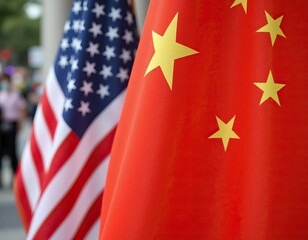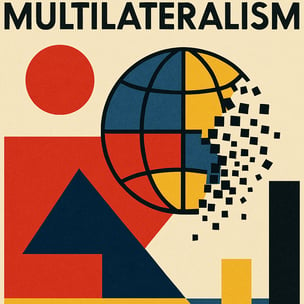The Influence of Sino-American Rivalry on Geopolitical Fragmentation
The growing rivalry between the United States and China is currently one of the main drivers of global geopolitical fragmentation. This phenomenon is expressed through the undermining of multilateral institutions, the formation of competing blocs, and the increased regionalisation of economic, technological, and security exchanges.
TENSIONS
Olivier Demain
5/30/202510 min read


The intensifying rivalry between the United States and China has emerged as a central force shaping the current landscape of global geopolitical fragmentation. As highlighted by numerous scholars (Allison, 2017; Ikenberry, 2020; Biscop, 2023), this competition is manifest in the erosion of multilateral institutions, the rise of competing blocs, and the growing regionalisation of economic, technological, and security relations. These developments signal a profound shift in the international order, with far-reaching implications for global stability and cooperation.
1. Erosion of Multilateralism
The growing strategic competition between the United States and China has profoundly undermined the effectiveness and legitimacy of key multilateral institutions. According to G. John Ikenberry (2020), this rivalry has led both powers to increasingly bypass or challenge the established rules and frameworks that have long underpinned global governance. Institutions such as the World Trade Organization (WTO) and the World Health Organization (WHO), once seen as pillars of international cooperation, have become arenas for contestation rather than consensus.
Ikenberry (2020) argues that the United States, traditionally the principal architect and guarantor of the liberal international order, has in recent years adopted a more unilateral approach, particularly under the Trump administration. This shift was exemplified by the US withdrawal from the Trans-Pacific Partnership (TPP), the Paris Climate Agreement, and its threats to disengage from the WTO. At the same time, China has sought to reshape these institutions to better reflect its interests and growing influence, often promoting alternative initiatives such as the Asian Infrastructure Investment Bank (AIIB) and the Belt and Road Initiative (BRI).
Both Washington and Beijing have also shown a preference for bilateral or minilateral agreements that allow them to exert greater control over outcomes. This trend is evident in the proliferation of trade wars, targeted sanctions, and exclusive partnerships, which sidestep broader multilateral consensus. As Sven Biscop (2023) notes, these practices contribute to the weakening of global governance by fostering the emergence of competing standards and parallel institutions, rather than reinforcing universal rules.
The consequences of this erosion are significant. The WTO, for example, has struggled to resolve disputes and enforce its rules, with its Appellate Body rendered inoperative due to the US blocking new appointments. Meanwhile, the WHO faced intense criticism and politicisation during the COVID-19 pandemic, as both the US and China sought to influence its agenda and narrative. These developments have diminished the capacity of multilateral organisations to respond effectively to global challenges, and have encouraged other states to adopt more fragmented and self-interested approaches.
2. Formation of Competing Blocs and Spheres of Influence
The intensifying rivalry between the United States and China is increasingly manifesting in the formation of competing blocs and the consolidation of distinct spheres of influence. Graham Allison (2017) famously describes this dynamic as a modern “Thucydides Trap,” a situation in which a rising power (China) challenges the dominance of an established power (the United States), often leading to heightened tensions and, historically, even conflict.
Allison argues that both Washington and Beijing are actively seeking to reinforce their own areas of influence, regionally and globally. For the United States, this involves deepening traditional security alliances and partnerships. Organisations such as NATO in Europe, the Quad (comprising the US, Japan, India, and Australia) in the Indo-Pacific, and the AUKUS pact (Australia, the United Kingdom, and the US) are being revitalised and expanded to counterbalance China’s growing assertiveness. These alliances serve not only as military deterrents but also as frameworks for economic and technological cooperation, promoting shared standards and values among member states.
On the other side, China is pursuing its own strategy to expand its influence, most notably through the Belt and Road Initiative (BRI). The BRI is a vast infrastructure and investment programme spanning Asia, Africa, Europe, and beyond, designed to enhance connectivity and economic integration on terms favourable to Beijing. Through the BRI, China has cultivated close relationships with a diverse range of countries, including those that are non-aligned or even in opposition to the West, such as Iran and Russia. These partnerships are often reinforced through bilateral agreements, investments, and the provision of alternative financial and technological resources.
This bifurcation of the international system is not limited to security arrangements. It extends to economic, technological, and even normative domains. For example, the US and its allies are increasingly coordinating on issues such as supply chain security, digital infrastructure, and the regulation of emerging technologies, often to the exclusion of China. Conversely, China is working with its partners to develop parallel systems and standards, including alternative payment networks and digital platforms.
The result is a world that is becoming more polarised and fragmented, with states increasingly pressured to align with one bloc or the other. This competition for influence is particularly acute in regions such as Southeast Asia, Africa, and the Middle East, where both the US and China are vying for strategic partnerships and access to critical resources.
3. Fragmentation of Global Value Chains
The intensification of the Sino-American rivalry has had profound effects on the structure of global value chains (GVCs), which had previously been a cornerstone of economic globalisation. Fouquin and Hugot (2016) explain that the escalation of trade tensions and the adoption of protectionist industrial policies by both the United States and China have triggered a process of “forced regionalisation” within these value chains.
The onset of the US-China trade war, marked by successive rounds of tariffs and retaliatory measures since 2018, has significantly increased the costs and uncertainties associated with cross-border production. Both countries have implemented policies aimed at reshoring or nearshoring critical industries, particularly in sectors deemed strategic, such as semiconductors, pharmaceuticals, and advanced manufacturing. According to Fouquin and Hugot, these measures are not isolated; they reflect a broader trend among advanced economies to reduce dependencies on foreign—especially Chinese—suppliers.
In response to these geopolitical risks, multinational corporations have begun to rethink and reorganise their supply chains. Many firms are adopting a “China plus one” strategy, diversifying production bases to include countries such as Vietnam, Mexico, or India, in order to mitigate the risks of over-reliance on any single country. Others are regionalising their supply networks, favouring suppliers and production facilities located closer to key markets. This shift is particularly evident in high-tech industries, where concerns about intellectual property theft, export controls, and national security are driving the creation of parallel, regionally focused supply chains.
The fragmentation of global value chains has several far-reaching implications. Fouquin and Hugot highlight that this trend undermines the efficiency gains traditionally associated with globalisation, as companies face higher costs and reduced economies of scale. Moreover, the regionalisation of supply chains reduces interdependence between regions, potentially decreasing the incentives for international cooperation and increasing the risk of economic decoupling.
This process also exacerbates inequalities between countries and regions. While some economies—such as those in Southeast Asia or Latin America—may benefit from the relocation of manufacturing activities, others risk being marginalised if they are unable to integrate into new regional networks. Furthermore, the fragmentation of GVCs can slow the diffusion of technology and innovation, as knowledge flows become more restricted within regional blocs.
Fouquin and Hugot demonstrate that the trade war and protectionist industrial policies pursued by both giants are leading to a “forced regionalisation” of value chains. Companies are reorganising their supply chains to limit exposure to geopolitical risks, which fragments the global economy and reduces interdependence between regions.
4. Technological Decoupling
Technological decoupling has emerged as a defining feature of the Sino-American rivalry, with profound implications for the global innovation landscape. As Sven Biscop (2023) notes, the competition between the United States and China is particularly intense in strategic sectors such as semiconductors, artificial intelligence (AI), and telecommunications (notably 5G). This rivalry is accelerating the formation of distinct “technological spheres,” each with its own standards, supply chains, and ecosystems.
The United States has taken a series of measures to limit China’s access to cutting-edge technologies. These include export restrictions and also pressured allied countries to exclude Chinese firms, such as Huawei and ZTE, from their 5G infrastructure, citing national security concerns. These actions are designed to slow China’s technological advancement and maintain US leadership in this critical sectors.
In response, Beijing has doubled down on its strategy of indigenous innovation, investing heavily in domestic research and development and supporting national champions in high-tech industries. China is also working to establish its own technological standards, particularly in areas like 5G, digital payments, and smart cities. These efforts are complemented by initiatives such as “Made in China 2025” and the Digital Silk Road, which aim to reduce dependence on foreign technology and promote Chinese standards internationally.
Biscop highlights that this technological decoupling is fragmenting global innovation networks. Instead of a single, interconnected system facilitating the free flow of ideas, talent, and components, the world is witnessing the emergence of parallel ecosystems. For example, the semiconductor supply chain is being reconfigured, with the US and its allies investing in domestic production capacity and China developing its own fabrication capabilities. Similarly, competing standards for 5G and other digital technologies are dividing markets and limiting interoperability.
The consequences of technological decoupling extend beyond the US and China. Third countries and multinational firms are increasingly forced to choose between competing technological ecosystems, which can raise costs, create inefficiencies, and stifle innovation. Moreover, the fragmentation of technology standards can hinder global cooperation on issues such as cybersecurity, data governance, and the regulation of emerging technologies.
5. Security Dilemmas and Regional Tensions
The militarisation of the South China Sea and the strengthening of regional alliances are central to the security dilemmas currently shaping the Asia-Pacific, as emphasised by Santander (2009) and Allison (2017). These developments have intensified regional polarisation and increased the risk of confrontation.
China’s rapid military build-up in the South China Sea has fundamentally altered the regional security environment. Since 2009, Beijing has expanded its sovereignty claims and established a near-permanent military presence on both natural and artificial islands, including Hainan, Woody Island, and the Spratly archipelago. This “continental militarisation” is designed to transform the South China Sea from an open international waterway into a Chinese-controlled strategic chokepoint, giving Beijing leverage over vital maritime routes and regional actors.
China’s approach combines conventional military deployments with “grey zone” tactics, such as the use of maritime militia and coast guard vessels to assert control and harass rival claimants. These actions have prompted neighbouring states—most notably Vietnam, the Philippines, and Indonesia—to modernise their own naval and coast guard capabilities in an effort to preserve the status quo, though their efforts are dwarfed by China’s military advances.
In response to China’s assertiveness, the United States and its allies have reinforced existing security arrangements and formed new partnerships to counterbalance Beijing’s influence. Alliances such as the US-Japan-Australia Trilateral Strategic Dialogue, the Quad (US, Japan, India, Australia), and AUKUS (Australia, UK, US) serve to coordinate security policies and enhance military interoperability. These alignments are complemented by regional security communities like ASEAN and strategic networks such as the Shanghai Cooperation Organisation (SCO), which offer alternative frameworks.
The proliferation of these “competing geometries” of security alignments reflects the broader grand strategic competition in the region. As China’s military and economic power grows, status quo powers—including Japan, Australia, and the US—are compelled to respond, sparking an arms race and raising the risk of miscalculation or conflict.
Countries such as Japan, Australia, and India have adopted “hedging” strategies to navigate the uncertainties of US commitment and the rise of Chinese power. Japan, for example, has sought to diversify its security partnerships, strengthening ties with Australia, India, and ASEAN states while maintaining its alliance with the US. This approach allows regional actors to balance against China without fully committing to one bloc, but it also contributes to the complexity and instability of the regional security order.
The South China Sea and East China Sea remain the most dangerous flashpoints, with frequent incidents involving military and paramilitary forces from multiple countries. The unresolved status of Taiwan and North Korea further compounds the risk of escalation. Major powers from outside the region—including France, the UK, and India—have also increased their naval presence, signalling the global significance of these tensions
Conclusion
The contemporary international landscape is being fundamentally reshaped by the intensifying rivalry between the United States and China. As Ikenberry aptly summarises, this great power competition serves as an “accelerator of fragmentation” within the global system. The consequences of this rivalry are far-reaching and multidimensional.
Firstly, the weakening of multilateral institutions—such as the WTO and WHO—has undermined the capacity for collective action and eroded the legitimacy of the rules-based order. Both Washington and Beijing increasingly favour unilateral or minilateral approaches, sidelining the very institutions that once provided a framework for cooperation and dispute resolution.
Secondly, the formation of competing blocs and spheres of influence has polarised the international community. Traditional alliances led by the United States, and China’s alternative partnerships and initiatives, have created parallel systems for security, trade, and technology. This bifurcation forces states and businesses to navigate a more complex and divided environment, often compelling them to choose sides or devise hedging strategies.
Thirdly, the fragmentation of global value chains and the rapid technological decoupling between the two powers are weakening the economic interdependence that once acted as a stabilising force in international relations. The emergence of distinct technological ecosystems and regionally focused supply chains is not only reducing efficiency and innovation but also increasing the risk of exclusion and marginalisation for third countries.
Finally, the security dilemmas and regional tensions exacerbated by this rivalry—particularly in the Asia-Pacific—have heightened the potential for miscalculation and conflict. The militarisation of contested spaces and the proliferation of alliances have created a security architecture that is increasingly rigid and prone to escalation.
Taken together, these developments signal a shift away from the post-Cold War vision of a cooperative, integrated global order. Instead, as Ikenberry have argued, the world is entering an era characterised by fragmentation, competition, and uncertainty.
References
Allison, G. (2017). Destined for War: Can America and China Escape Thucydides’s Trap? Houghton Mifflin Harcourt.
Biscop, S. (2023). Grand Strategy in 10 Words: A Guide to Great Power Politics in the 21st Century. Routledge.
Fouquin, M. & Hugot, J. (2016). Regionalisation, the Engine of Globalisation, CEPII.
Ikenberry, G. J. (2020). A World Safe for Democracy: Liberal Internationalism and the Crises of Global Order. Yale University Press.
Santander, S. (2009). The Emergence of New Powers: Towards a Multipolar System? University of Liège.










